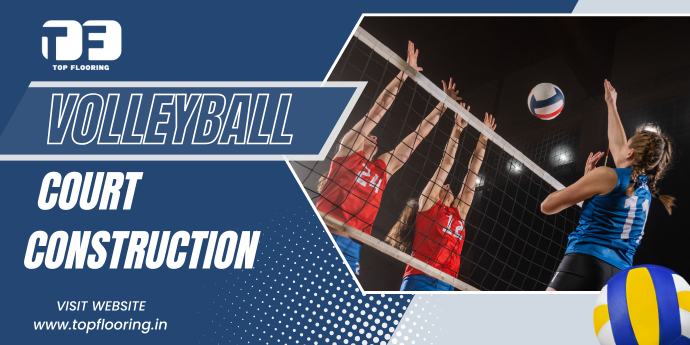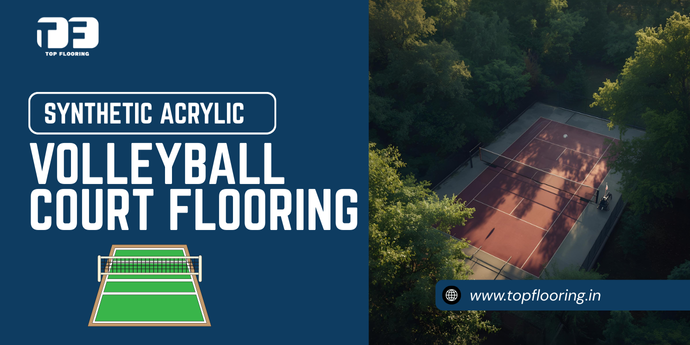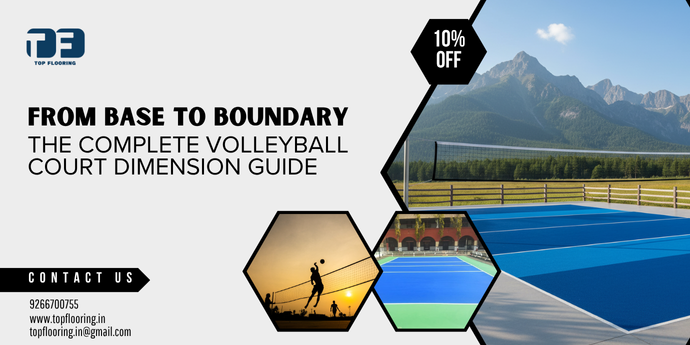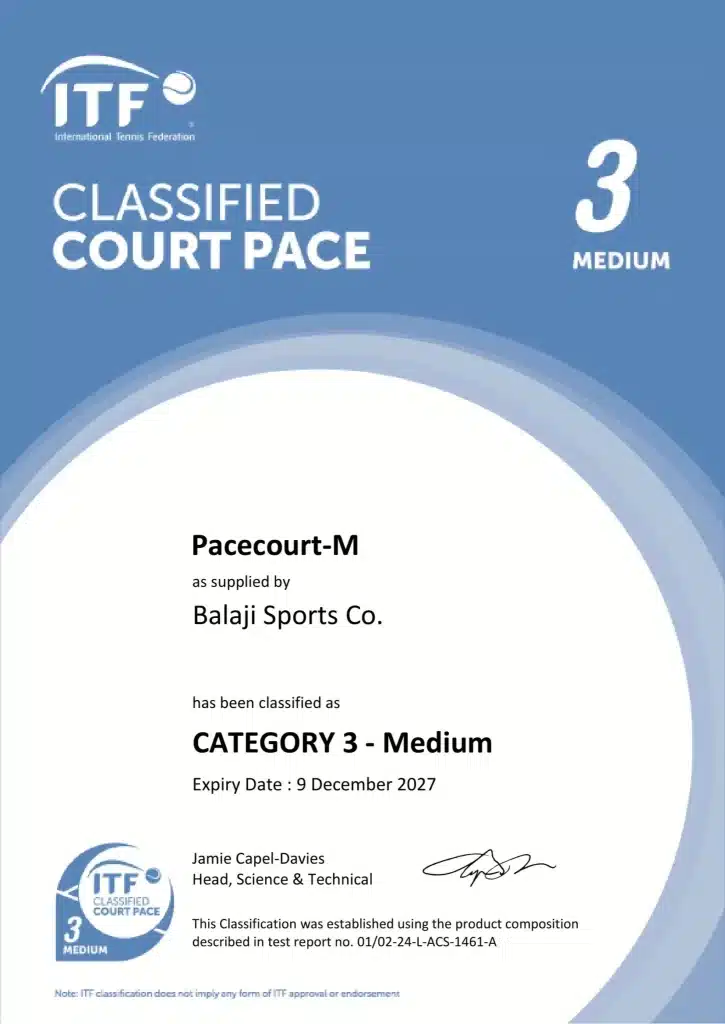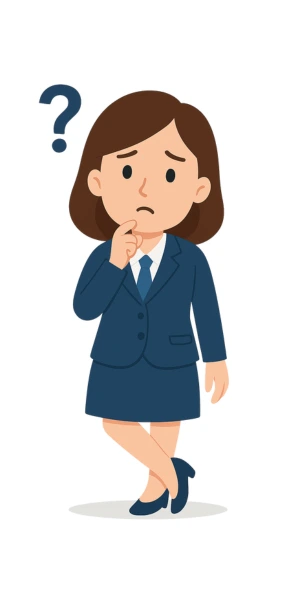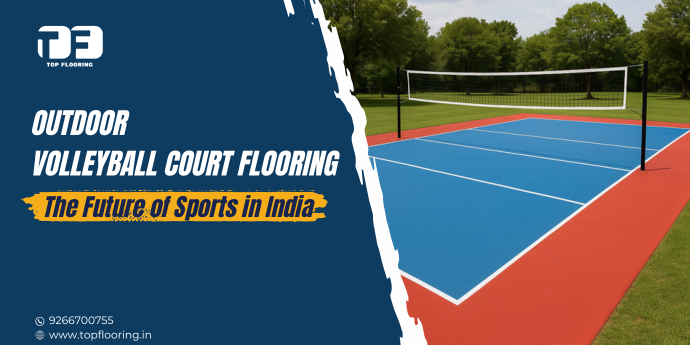
Volleyball is one of the few sports that brings people together across all age groups, from school kids learning the basics of teamwork to professional athletes competing in tournaments. In India, the sport has seen tremendous growth over the last decade, driven by the increasing popularity of fitness activities, sports leagues and the demand for good quality community facilities. From housing societies in metro cities to schools and local sports clubs in smaller towns, volleyball court flooring is becoming an essential part of modern infrastructure. The lifespan of a volleyball court depends entirely on the flooring. While casual games on dusty grounds or cemented slabs were the norm in the past, today’s players expect more. Surfaces that are too hard can cause injuries, uneven flooring affects gameplay.
Communities investing in sports infrastructure want courts that are visually appealing, easy to maintain and global standards compliant. This is where the choice of outdoor volleyball court flooring material becomes critical. The advanced volleyball flooring materials like acrylic systems has changed the way volleyball courts are built in India. No longer just about creating a play area, building a volleyball court means designing a safe, sustainable and professional grade facility. And at the forefront of this change is Top Flooring, a company that has become the trusted partner in synthetic volleyball court construction across the country.
This blog covers the entire spectrum of outdoor volleyball court flooring – from the consequences of choosing the wrong volleyball court material to the benefits of synthetic systems, cost, construction details and why Top Flooring is the go-to choice for schools, clubs and communities.
What Happens When Wrong Volleyball Court Material Is Used?
Using the wrong volleyball court flooring material is one of the biggest mistakes in court construction. Many projects in India still use basic cement surfaces or tiled finishes because they seem cost effective initially. But over time the flaws become apparent:
- Cracks and Uneven Surfaces: Cement and tiles are highly prone to India’s weather conditions. With the constant expansion and contraction under heat, cold and rain, these surfaces develop cracks which compromise the court.
- Slipperiness: Outdoor cement and tile surfaces absorb water during monsoons and retain moisture in humid conditions, making the court slippery. A wet court increases the chances of sudden slips, falls and injuries. Even during dry seasons, dust accumulation makes cement courts slippery and unsafe.
- Player Fatigue: Hard, unyielding floors like cement offer no shock absorption. When players jump, land or make quick lateral movements, the impact is transferred directly to their joints. Over time this leads to fatigue, discomfort and even chronic issues in the knees, ankles and lower back.
- High Maintenance: At first glance cement or tiled volleyball courts seem like the cheaper option. But once cracks appear, surfaces fade and line markings wear out, the need for frequent patching and repainting becomes inevitable.
This is exactly why professional schools, institutions and clubs are moving towards synthetic volleyball court construction. Synthetic acrylic systems are weather resistant, provide cushioning for safe play and require minimal maintenance making them a far more reliable and sustainable flooring solution than cement or tiles.
How Do Modern Outdoor Volleyball Court Materials Perform Better?
Unlike traditional surfaces, modern outdoor volleyball court flooring is designed with advanced technology that prioritizes performance, safety and longevity. Each feature is designed to overcome the limitations of cement or tiled courts and meet international standards for competitive play. Here’s how they score:
- UV Resistance: In India the summer heat and constant sunlight is a big challenge. Traditional cement or tile courts fade, peel or develop cracks. Modern volleyball flooring materials like acrylic coatings are formulated with UV stable compounds that resist sunlight damage.
- Slip Resistance: Outdoor play comes with unpredictable weather – humid conditions, light rain or morning dew. Conventional surfaces become slippery in such conditions. Synthetic acrylic systems have textured finishes that provide grip without being abrasive.
- Shock Absorption: Volleyball is a fast paced game with constant jumps, dives and quick movements. Hard surfaces like cement put excessive pressure on joints and increase the risk of chronic knee and ankle problems. Modern synthetic systems have cushioned base layers that absorb impact.
- Consistent Bounce: A critical element of any volleyball match is the bounce of the ball. Uneven cement surfaces, cracks or patches disrupt gameplay and frustrate players and referees. Synthetic acrylic flooring provides a uniform surface across the entire court.
- Customizable Design: Beyond performance, aesthetics also play a big role in modern court construction. Acrylic and synthetic surfaces can be finished in vibrant, weather proof colors with sharp, fade resistant line markings.
These are the advantages of outdoor volleyball court flooring – an investment not an expense. Unlike traditional surfaces that need constant maintenance and repairs, synthetic acrylic systems offer durability, safety and professional level performance that lasts.
Acrylic Volleyball Court Flooring
When it comes to volleyball flooring, acrylic is the best option for outdoor courts in India. It’s the perfect blend of affordability, durability and quality for schools, housing societies, clubs and sports academies.
- Durability: Acrylic can withstand India’s extreme weather conditions – from scorching summers to heavy monsoon rains. Unlike cement or tiles that crack and fade, acrylic coatings remain intact for years, giving consistent bounce and slip resistance even with continuous use.
- Affordability: Compared to PU or modular tiles, acrylic is the most practical balance of cost and performance. It gives professional grade playability without burning a hole in your pocket, making it ideal for big institutions and small community projects.
- Certifications: The acrylic systems provided by Top Flooring are ITF classified and ISO certified. This ensures courts meet international standards for safety, quality and performance – a must for organizations hosting tournaments or training athletes.
- Customization: Acrylic courts are available in various vibrant, UV stable colors. From standard green and blue combinations to custom designs that match your branding or school colors, courts can be designed for both looks and high performance with precise line markings.
- Low Maintenance: One of the biggest advantages of acrylic is its low maintenance. With just basic cleaning and occasional washing, the surface stays in great condition. And resurfacing is required only once in 5-7 years, making it a cost effective long term investment.
So acrylic has emerged as the most trusted outdoor volleyball court flooring, giving a safe, professional and durable playing surface across India’s diverse climate and usage requirements.
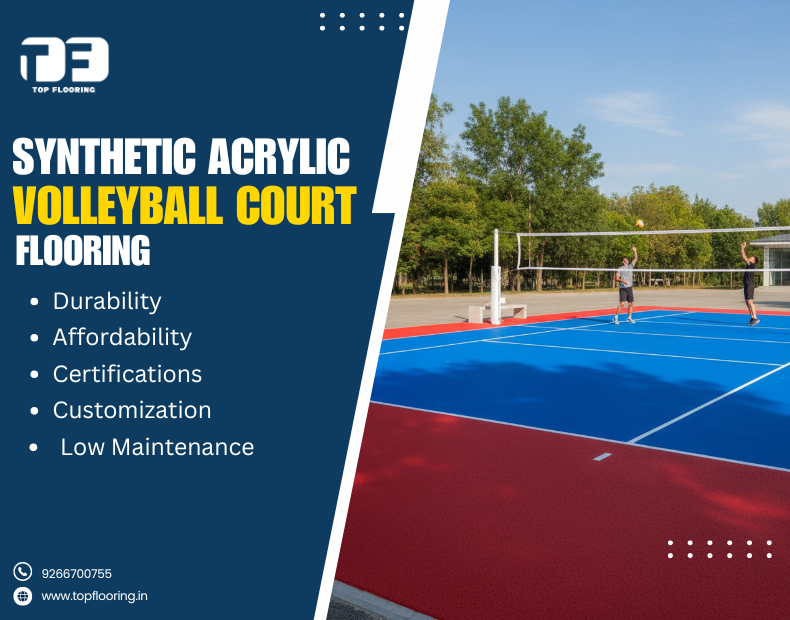
When to Choose Synthetic Volleyball Court Construction
Investing in synthetic volleyball court construction is not just about building a surface to play on, it’s about making the right decision at the right time. The timing often depends on purpose, community needs and long term vision. Here are situations where opting for synthetic courts makes sense:
- New Developments: For housing societies, colleges or sports academies, adding a professional outdoor volleyball court flooring is one of the best ways to attract residents and students.
- Upgrading Old Courts: Many institutions and communities still have cement courts built years ago. Over time these courts crack, become unsafe and unfit for serious play. Players struggle with inconsistent bounce and higher risk of injuries on such outdated flooring.
- Community Sports Programs: Municipalities and organizations promoting fitness and wellness can make a big impact by investing in construction of volleyball courts with synthetic flooring systems.
- Tournaments and Professional Play: When clubs, schools or organizations host district, state or national tournaments, the courts must comply with volleyball court construction details as per international standards.
Waiting too long to make the switch results in higher repair bills, unsafe playing conditions and missed opportunities to promote sports. Early investment in synthetic volleyball court construction gives you value, durability and safety and positions the facility for future use and professional play.
Volleyball Court Construction Cost in India
The volleyball court construction cost in India varies depending on several key factors that affect both the initial investment and long term maintenance. Knowing these factors helps schools, housing societies, clubs and institutions plan better and choose the right flooring material for their budget and requirements.
- Base Preparation: A strong foundation is essential for long term court durability. Proper base preparation involves RCC or asphalt flooring with slope and drainage system to prevent water accumulation. Without this step even high quality volleyball flooring material can develop cracks or lose grip over time.
- Volleyball Court Flooring Material: The choice of volleyball court material has the biggest impact on overall cost. Acrylic systems are the most cost effective, excellent performance at reasonable price. PU surfaces provide added cushioning but are expensive, modular PP tiles are quick to install but not suitable for Indian outdoor weather.
- Court Size: The standard size of an outdoor volleyball court is 18m x 9m, but projects often require extra run-off zones for player safety or multiple courts in large institutions. Larger courts means more flooring material, extended base preparation and higher cost.
- Accessories: Beyond flooring several essential and optional accessories affect the total cost. These include net posts, high quality nets, fencing for safety and floodlighting for evening play.
- Location: Geography and logistics play a hidden but significant role in determining volleyball court construction cost. Cost varies based on labour charges, transportation of materials and local climate conditions.
On an average outdoor volleyball court flooring with acrylic systems is the most cost effective and affordable option for Indian weather conditions. It offers the perfect blend of affordability, durability and low maintenance making it the preferred choice for schools, clubs and residential complexes looking to invest in long term sports infrastructure.
How Does Top Flooring Deliver Excellent Volleyball Court Construction?
Top Flooring is one of India’s most trusted names in volleyball court construction, setting high standards in quality, durability and service. The brand’s leadership is built on several pillars that gives value to clients:
- Certified Materials:Top Flooring uses only ITF classified and ISO certified volleyball flooring material. These certifications make sure that the volleyball courts meet international safety and performance standards.
- Pan India Reach: With more than 200 dealers across India, the company can provide quick delivery, seamless installation and after sales service wherever the project is located.
- Customized Solutions: India is a big country with diverse geography and climate from heat summers in plains to heavy rains in sea side cities. Top Flooring specializes in customized outdoor volleyball court flooring solutions that suit local conditions.
- Expertise: With years of hands-on experience, Top Flooring has mastered the art of synthetic volleyball court construction. The company has completed projects for schools, universities, housing complexes and sports clubs across India.
- Cost: Top Flooring believes in complete transparency when it comes to volleyball court construction costs. Instead of unclear quotes, clients get detailed, itemized breakdowns of each and every expense whether its base preparation, volleyball court flooring material or accessories like nets and poles.
- Track Record: Reputation is built on results and Top Flooring has a proven track record of delivering projects across India. From small community volleyball courts to large multi-sport complexes, their portfolio has hundreds of installations that are running smoothly years after completion.
Why Outdoor Volleyball Court Flooring Is More Than Just a Sports Investment
A good volleyball court goes beyond being a play area; it becomes a social hub, fitness center and community builder. Communities that choose outdoor volleyball court flooring benefit in many ways:
- Youth Engagement: A professional built volleyball court attracts young players and keeps them active. In today’s screen world, sports facilities are a good option.
- Community Identity: Outdoor volleyball courts become gathering points for residents, students and local athletes. Whether for weekend matches, school tournaments or casual games, a volleyball court built with volleyball court flooring strengthens social bonds.
- Property Value: Housing societies and educational institutions with modern sports facilities are more attractive. A well maintained court built with outdoor volleyball court flooring increases property value by offering courts that families look for.
- Sports Culture: By investing in synthetic volleyball court construction, communities open up opportunities for training programs, school competitions and even city events.
So choosing the right volleyball court flooring should always be a long term decision not just a short term one. A well built volleyball court becomes a long term asset that contributes to health, unity and growth of the entire community.
How to Maintain Outdoor Volleyball Court for Long Term
Even the best volleyball court flooring needs to be maintained to be safe, perform and last long. Regular maintenance not only keeps the volleyball court looking new but also saves you from costly repairs in future. Here are the best practices to maintain an outdoor volleyball court:
- Daily Sweeping: Dust, dry leaves and debris collect on outdoor courts especially in housing societies or open fields. These reduce surface grip making the volleyball court slippery and unsafe.
- Monthly Washing: Over time sweat, dirt and minor stains can dull the volleyball court’s surface texture. Washing the court once a month with mild soap and soft brushes helps to preserve the original finish.
- Annual Inspection: Small issues like cracks, fading line markings or low spots caused by water seepage may seem harmless at first but can quickly grow into big problems.
- Resurfacing: Every outdoor volleyball court no matter how well built experiences wear and tear from weather and gameplay. Resurface the volleyball court every 5-7 years to restore the slip resistance, vibrant colors and cushioning properties.
With these simple but consistent steps an acrylic volleyball court can last more than a decade while being safe, playable and visually appealing. Proper maintenance ensures players have the best experience and institutions protect their investment in outdoor volleyball court flooring materials.
Conclusion
Volleyball in India is growing and so is the importance of sports infrastructure to create healthier and more active communities. Schools are introducing structured physical education, housing societies are promoting wellness facilities and sports clubs are investing in competitive events, the demand for professional outdoor volleyball court flooring material will only increase.
Traditional methods of court building can no longer keep up with these expectations. Cracked cement slabs and uneven surfaces not only ruin the game but also discourage participation due to injury risks. Synthetic volleyball court construction with certified volleyball flooring materials ensures safety, comfort and performance. Acrylic systems are proving to be the smartest long term investment affordable, durable and low maintenance.
In this journey Top Flooring has become more than a supplier, it is a strategic partner. With ITF classified and ISO certified systems, expert builders and a pan India presence, Top Flooring ensures that every project meets the highest standards of quality and reliability. Whether it’s a small residential project or a large sports academy, Top Flooring provides the expertise and materials to create courts that last long.
Frequently Asked Questions
The cost depends on base preparation, flooring material, and accessories, but acrylic systems are the most cost-effective option.
Acrylic is the most durable and affordable choice, offering UV resistance, slip safety, and consistent bounce.
A standard court is 18m x 9m, with a 3m free zone, multi-layer acrylic flooring, and a 1% slope for drainage.
Synthetic courts ensure long-term durability, reduced maintenance, and compliance with international standards, making them ideal for communities.

